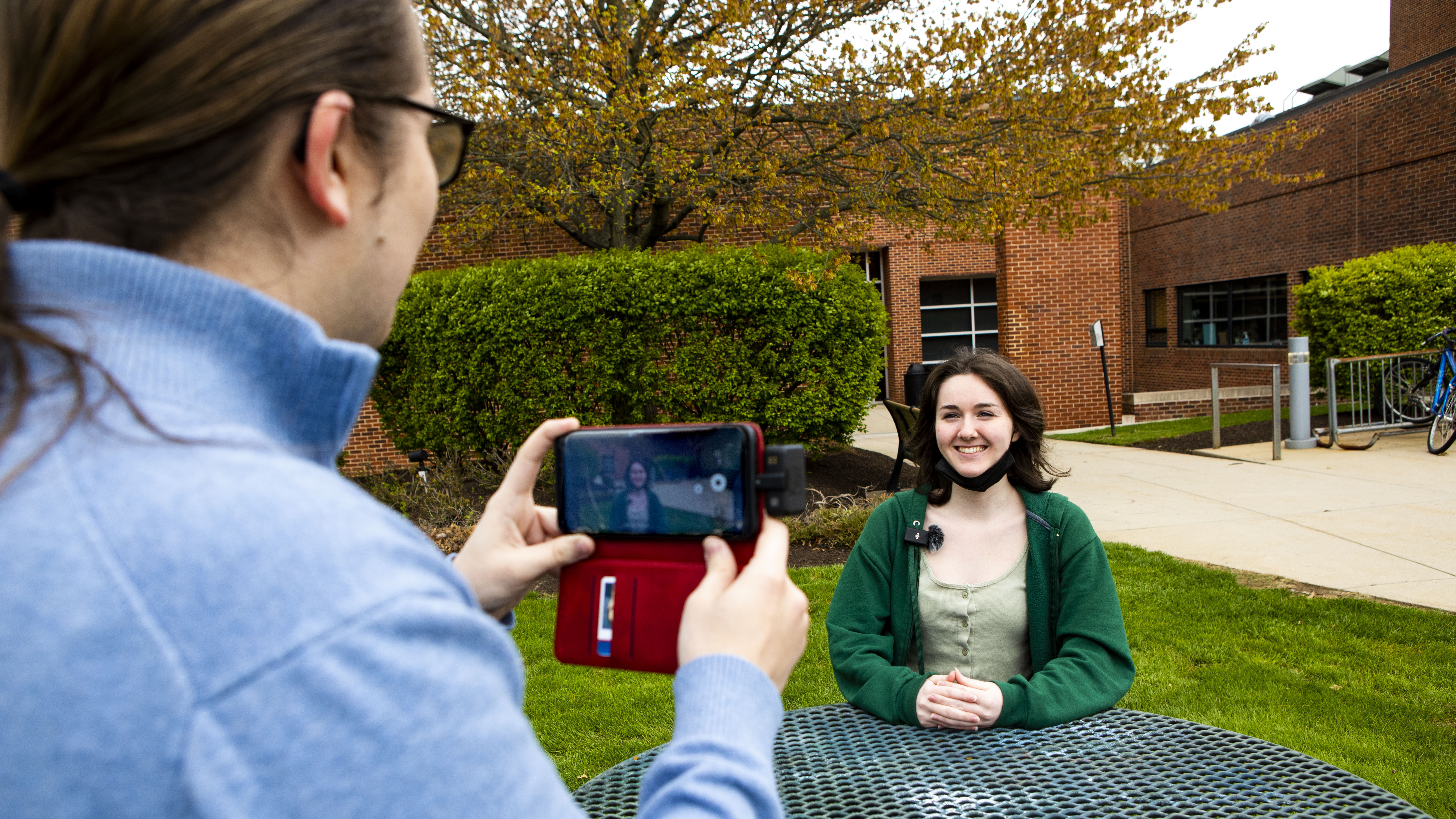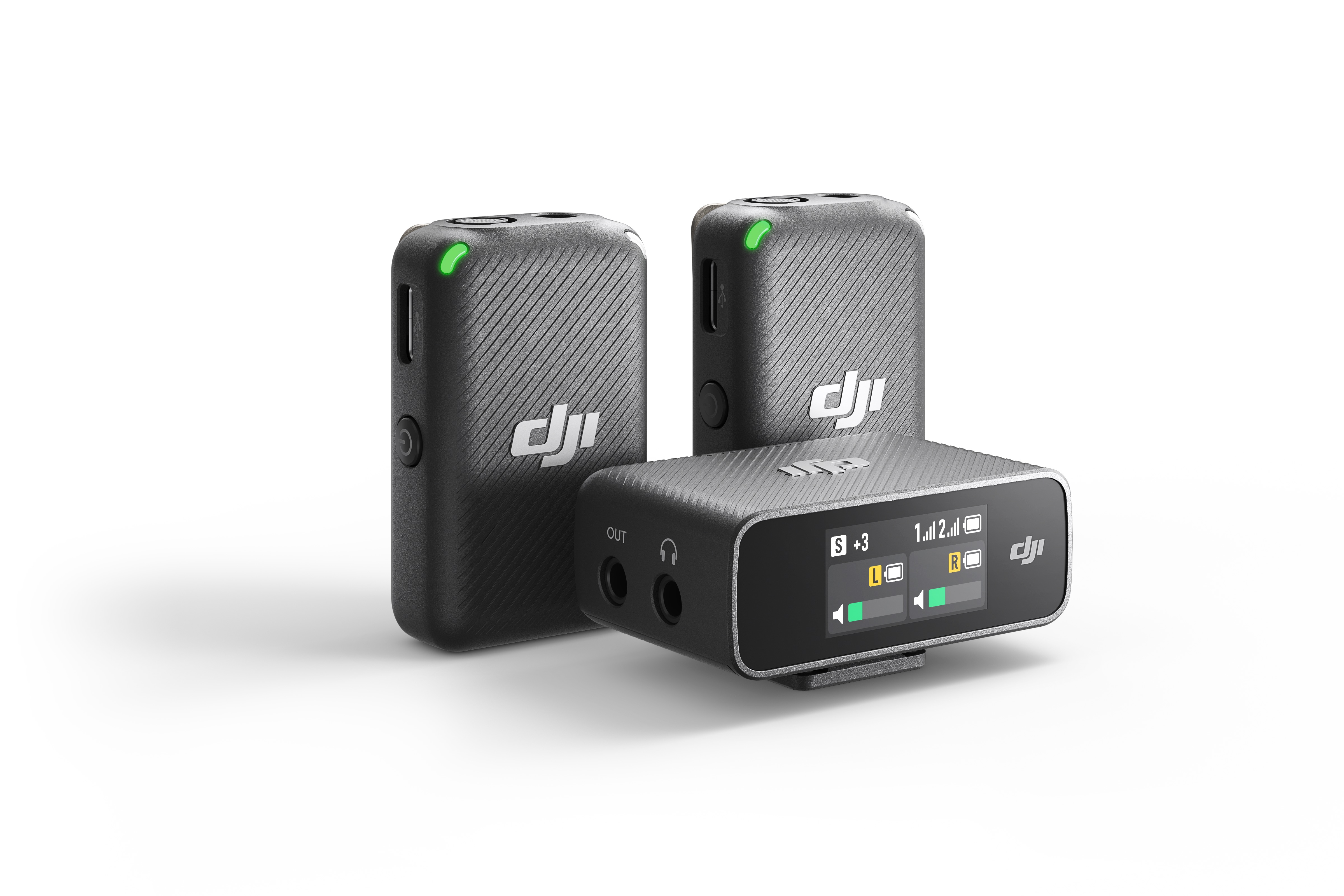SCN Review: DJI Mic Offers Versatile Wireless Audio Recording Solution
The DJI Mic worked effectively for an outdoor interview on a windy day using a smartphone as the camera.

The new DJI Mic audio system is small but is packed with features. It contains two wireless transmitters with built-in recorders, two windscreens, 3.5mm TRS-to-USB adapters, lighting and USB–C connections, cabling, wireless receiver, charging case, and carrying pouch. It's designed to work with smartphones and digital cameras, but can also be used for meetings, lectures, or anywhere a wireless microphone with an internal recorder might be useful.
One of the biggest issues with wireless technology is the potential for interference between the transmitter and receiver. While you have the benefit of not dealing with wires, potential audio break-up has created a stigma with using this technology for some. DJI has solved part of this problem by having a reliable backup recorder built in each transmitter. This “safety” relieves much of the stress associated with hoping interference between the microphone and receiver doesn’t occur.
Three-Part Harmony
Looking at one of the miniscule (less than 2 inches on its longest side), 100mW RF output transmitters, the 24-bit, 48kHz device records an adjustable level mono WAV file. It operates in the 2.4GHz frequency band and boasts an 820-foot line-of-sight operating range. Each transmitter includes 8GB of storage and is powered by a 320mAh lithium battery, which delivers more than five hours of use on a 70-minute charge.
[SCN Hybrid World Review: 4 Selling Points for the Shokz OpenComm UC Headset]
The top of the transmitter houses the electret condenser omnidirectional microphone, which accepts an included twist-on windscreen and includes a 3.5mm mini-input for attaching an external microphone. A USB-C port allows for charging or retrieving recorded data from the internal drive.
When you hold the power button, it activates a single vibration and lights a green power LED. The other side of the unit houses the linking button to pair the transmitter and receiver. Directly below is the record button, which activates another vibration and lights a red LED. Pressing it again stops the recording. The bottom features a charging pad, while the back includes a clip with an incredibly strong magnet.
The 50Hz-20kHz receiver (also less than 2 inches on its longest side) contains a five-hour lithium battery with a 160-minute charge time. The 9-ounce device features an organic LED (OLED) touchscreen that displays pertinent information, including recording mode, audio level, left and right transmitter signal strength, receiver battery charge, and receiver gain and battery level on each transmitter. Swiping down on the screen reveals the battery charge, volume, record mode (stereo, mono, and mono safety track), receiver gain, headphone/monitor volume, and other general settings.
A daily selection of features, industry news, and analysis for AV/IT professionals. Sign up below.
[Review: How to Produce an Affordable Podcast with Multiple Mics]
Facing the receiver, the left side has both the 1/8 inch mini-3.5mm output and headphone/monitor jacks. The right side features the power button and USB-C port that is used for charging, receiving firmware updates, and as a computer microphone. As on the transmitter, the bottom contains the charging pad.
Weighing slightly over a pound is the carrying case. The front of the case has LEDs that indicate the level and status of the charge. The receiver is housed in the center of the case, with a transmitter to either side. The case also holds a hot shoe mount and USB-C and Lightning audio adapters. On the back is a female USB-C port for charging with the included cable.

So Many Uses
My DJI Mic arrived just in time to use and test its functionality for four separate projects: recording a meeting with two speakers for transcription, connecting to a presenter’s PA system, recording an outdoor interview via smartphone, and taking audio notes on an installation site. Here's how the DJI Mic performed in each scenario.
I have to attend many meetings, and I don’t like to rely on my own scribbled notes from a speaker who talks rapidly. What a perfect use for the DJI Mic, I thought. With two people discussing the intricacies of a new system they were installing, I wanted to preserve the discussion so I could better digest smaller chunks of information later. Others in the meeting had their phones on the table recording the presentation, but every time someone coughed or hit the table accidently, that “noise” would drown out what was said (the magic of automatic gain control). But I had both speakers wear a DJI omnidirectional microphone, so I could hear each of them as well as comments from others at the meeting, and the files from each microphone easily transferred to my computer.
[SCN Product Review: 3 Things to Know about the Jabra Engage 55 Headset]
One of the guest lecturers in my class was losing her voice and requested a PA system in our TV studio. We don't have a system like that in place; instead, I clipped one of the DJI mics to her collar and connected the receiver to our XLR breakout box, which fed our audio mixer in the control room. She could now move freely through the studio and her voice was heard through the speakers. Luckily, we had the right connectors to accept the 3.5mm output and convert it to an XLR male.
Using his Android smartphone as a camera, one of my students, Tom, needed to record an outdoor interview, but the audio from the phone alone was unusable because of the wind. Instead, we connected the DJI receiver via the USB-C connector to the bottom of his phone. We attached the windscreen to the mic and were able to monitor the recording by attaching headphones to the side of the receiver. A great feature of the DJI Mic is that the transmitter records a backup audio track, so if something had gone wrong on the phone, we still had the audio.
My last use of the DJI Mic was to make audio notes of a freelance installation I was doing for a client. With the transmitter clipped to my shirt pocket, I walked through the client’s office asking what he specifically wanted, took many measurements, selected the equipment he desired, and answered all his questions. In the past I had taken notes, especially when taking measurements. The reliability of recording the measurements and selection of equipment helped to ensure the accuracy of the process. I asked the client if he minded if I recorded our discussion and he said, “I would prefer that you record everything.”
A Few Suggestions
With its small size, portability, redundancy of transmitting and recording, omnidirectional pickup pattern, on-board recording, long line-of-sight range between transmitter and receiver, and extended battery life, the DJI Mic is a winner. Of course, it's not the most discreet wearable mic on the market, and there is always room for improvement.
[AV Network's top stories, product news, and expert insights](opens in new tab)
For example, the record button is too easily activated. I’m not sure what a better solution would be, but the vibration alert does help. Also, the magnet on the transmitter’s clip is far too strong. I appreciate the feature, but when you need to use a tool to separate it, that’s too much.
The swiping action of the receiver’s touchscreen takes several attempts to accurately advance the settings. Finally, and this one is also minor, is the removal the Lightning or USB-C connectors from the carrying case. You need needle-nose fingers to remove them when the hot shoe mount falls out (which is every time I remove the receiver). Despite the nitpicks, DJI has a hit with this wireless microphone/recorder package.
Chuck Gloman, Associate Professor, has more than 40 years of experience as a producer and director of photography with more than 900 TV commercials, 250 corporate videos, and 100 documentaries to his credit. His films have aired on HBO, Cinemax, and network television. He is the author of Placing Shadows: The Art of Video Lighting, 2nd Edition (Focal Press: 2000); No Budget Digital Filmmaking (McGraw-Hill: 2002); 303 Digital Filmmaking Solutions (McGraw-Hill: 2002); 202 Digital Photography Solutions (McGraw-Hill: 2003); Placing Shadows: The Art of Video Lighting, 3rd Edition (Focal Press: 2005); Scenic Design and Lighting Techniques (Focal Press: 2006); Working with HDV (Focal Press: 2006); Placing Shadows: The Art of Video Lighting, 3rd Edition (translated in Japanese Language Focal Press: 2007); and Placing Shadows: The Art of Video Lighting, 3rd Edition (translated in Chinese Language Focal Press: 2017). He has published more than 500 articles.

